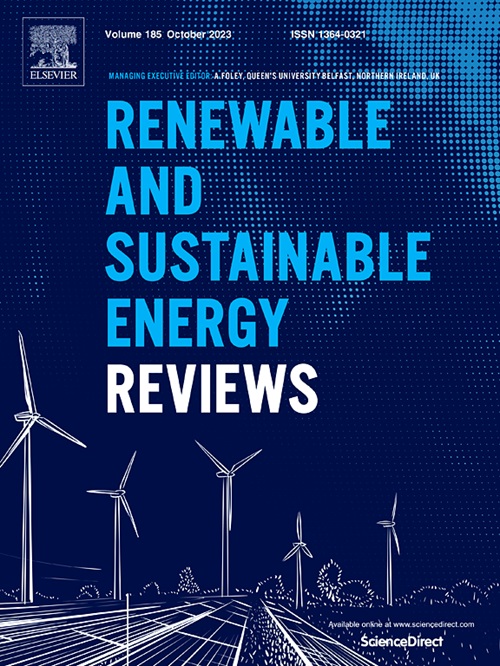二氧化碳衍生燃料生产催化剂设计的可持续性评估
IF 16.3
1区 工程技术
Q1 ENERGY & FUELS
引用次数: 0
摘要
将平准化碳减排成本 (LCCA) 和技术学习曲线 (TLC) 结合起来,以评估当前在加快部署基于二氧化碳的可再生燃料方面存在的技术差距。这项研究从三个层面进行:评估费托合成(FTS)催化剂改进对产品的影响、估算二氧化碳排放的潜在减少量以及计算每单位避免的二氧化碳排放的成本减少量。一种新颖的混合方法结合了自下而上的 TEA 和 LCA 工具来评估 FTS 催化剂,而自上而下的 TLC 方法则评估二氧化碳转化为喷气燃料 (CtJ) 平台的未来预测。在此范围内,对新设计的 FTS 催化剂(CYL)和 CtJ 平台上的传统催化剂(COC)进行了评估和比较。用 CYL 替代 COC 会导致催化剂成本增加 170%。然而,尽管催化剂成本增加,CtJ 平台的总体燃料产量却提高了 16%,能效提高了 +13%。因此,与 COC 相比,从 2027 年到 2050 年,CYL 催化剂能够以更低的成本(-15% 到 -17%)生产喷气燃料和柴油。此外,在二氧化碳净捕获量相同的情况下,CYL 所需的二氧化碳捕获量比 COC 低 15%,因此 CtJ 平台的二氧化碳排放量比 COC 低 41%。预计 2030 年二氧化碳衍生燃料的 LCCA 将非常接近每吨 170 美元的二氧化碳碳税目标。因此,二氧化碳衍生喷气燃料有望在加拿大市场上与化石燃料竞争。本文章由计算机程序翻译,如有差异,请以英文原文为准。

Sustainability assessment of catalyst design on CO2-derived fuel production
Levelized carbon cost abatement (LCCA) and technology learning curves (TLC) are combined to assess the current technology gaps for expediting the deployment of CO2-based renewable fuels. This study is conducted across three levels: Assessing the impact of the Fischer-Tropsch Synthesis (FTS) catalyst improvement on products, estimating the potential reduction in CO2 emissions, and calculating the cost reduction per unit of avoided CO2 emissions. A novel hybrid approach combines bottom-up TEA and LCA tools to assess FTS catalysts, while top-down TLC methodology evaluates future projections of the CO2 to jet fuel (CtJ) platform. The evaluation and comparison of the newly designed FTS catalyst (CYL) and a conventional catalyst (COC) on the CtJ platform are conducted within this scope. Replacing COC with CYL leads to an increase of >170 % in catalyst cost. However, despite the increase in catalyst cost, the overall fuel production of the CtJ platform is boosted by 16 %, and the energy efficiency is improved by +13 %. Consequently, the CYL catalyst enables the production of jet fuel and diesel at a lower cost (−15 % to −17 %) compared to COC from 2027 to 2050. Furthermore, for both cases' equal net CO2 capture, CYL requires 15 % lower CO2 capture and thus 41 % lower CO2 emissions from the CtJ platform than COC. LCCA of CO2-derived fuels is projected to be very close to the $170/tonne CO2 carbon tax target in 2030. Thus, CO2-derived jet fuels are expected to compete with fossil fuels in the Canadian market.
求助全文
通过发布文献求助,成功后即可免费获取论文全文。
去求助
来源期刊

Renewable and Sustainable Energy Reviews
工程技术-能源与燃料
CiteScore
31.20
自引率
5.70%
发文量
1055
审稿时长
62 days
期刊介绍:
The mission of Renewable and Sustainable Energy Reviews is to disseminate the most compelling and pertinent critical insights in renewable and sustainable energy, fostering collaboration among the research community, private sector, and policy and decision makers. The journal aims to exchange challenges, solutions, innovative concepts, and technologies, contributing to sustainable development, the transition to a low-carbon future, and the attainment of emissions targets outlined by the United Nations Framework Convention on Climate Change.
Renewable and Sustainable Energy Reviews publishes a diverse range of content, including review papers, original research, case studies, and analyses of new technologies, all featuring a substantial review component such as critique, comparison, or analysis. Introducing a distinctive paper type, Expert Insights, the journal presents commissioned mini-reviews authored by field leaders, addressing topics of significant interest. Case studies undergo consideration only if they showcase the work's applicability to other regions or contribute valuable insights to the broader field of renewable and sustainable energy. Notably, a bibliographic or literature review lacking critical analysis is deemed unsuitable for publication.
 求助内容:
求助内容: 应助结果提醒方式:
应助结果提醒方式:


